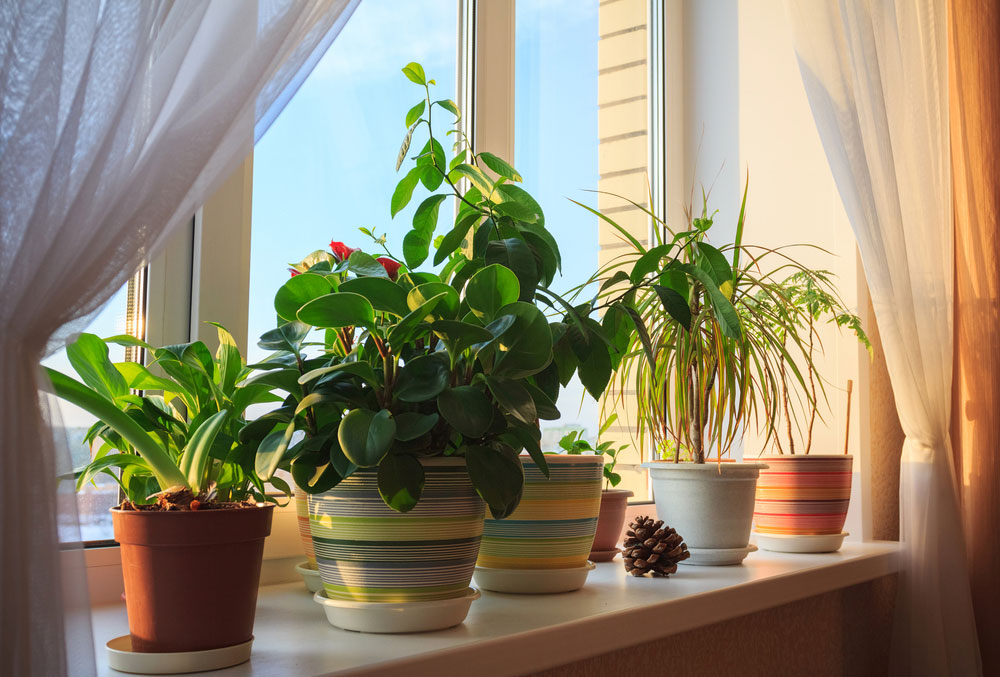BRINGING HOUSEPLANTS IN FOR THE WINTER
We are less than a week away from October. October is when we begin the dialogue with customers about prepping their houseplants for coming inside. Most tropical plants do not like temperatures below 50 degrees. And, this is certainly possible in October. Matter of fact, around October 20 is our average first frost date for the fall season. Any tropical plants left outside into late October will certainly be damaged or killed with a frost.
So, if your houseplants spend the summer outside, they may have picked up a few friends. In addition, with the favorable growing conditions outside – increased light, humidity, and air circulation – your plants may have gotten a little too big or unshapely over the summer. A little judicious pruning may be all your plants need.
I think some customers have already started prepping their houseplants for transporting back inside because they are asking about re-potting. Bottom line – Fall is not the best time to repot unless a plant is desperate for more space. Most indoor plants slow their root and foliage growth over the winter. The best advice we give customers is to place your houseplants into a beautiful, decorative pot without repotting and wait until next spring for repotting. Right now we have a fantastic selection of beautiful glazed containers in all different colors, shapes, and sizes.
Another important tip on houseplant care is to check your plants carefully (leaves and stems) for any signs of plant pests such as mealybug, scale insects, mites, aphids, caterpillars, etc. If you see pests or find pest damage, like chewed or stipples leaves, insect droppings, sticky leaves, or webbing, treat plants before bringing them inside (start early and watch the weather).
Before bringing out the chemicals, try a few simple home remedies. For easily dislodged insects like aphids, crickets, Daddy-longlegs, or spiders, try spraying them off with water from the hose. Caterpillars and grasshoppers can be picked off by hand.
Critters that have taken up residence in the soil can be removed by “cleaning” the soil with a chlorine bleach drench. The recipe is to use ¼ cup of bleach to a gallon of water. Slowing water the plant until the water comes out of the drainage hole. This procedure will ensure that the entire soil system has been treated. This recipe is strong enough to chase out soil insects and kill soil gnats but will not harm the houseplant. Please, this recipe is for the soil and do not spray on the foliage. If you suspect a heavy infestation of soil critters then you can submerge the entire pot in a bucket of water for 30 minutes or more – air-breathing insects like ants, pill bugs, centipedes, etc., will either float to the surface or drown.
With a mild infestation of mealybug or scale you can remove any pests you see with a cotton swab dipped in rubbing alcohol.
If you still feel your houseplants are infested then I would suggest using an insecticidal soap or a horticultural oil spray. We carry both products. These products should be applied outside in shade, and allowed to dry before bringing the plant inside. As always with any product, be sure to read the label for information on safe temperatures for spraying.
Once the plant is inside and if you notice small flying insects coming out of the soil – this is probably fungus gnats or whitefly. For easy monitoring and control, use the yellow sticky bars (also called whitefly traps) that are placed near the plant.
I hope this information helps you with taking proper care of your houseplants and keeping them healthy and happy for the winter until they can go back outside next spring.
HAPPY ‘HOUSEPLANTING’


Every year I lose a large part of my schefflera to some kind of sticky aphid-like bug. I will rinse the soil and use a pre-treatment this year, but is there something specific I need to do to treat this pest? The plant appears clean and healthy when I bring it indoors. These bugs seem to materialize out of thin air. The do not appear on any of my other plants that spend summer outside.
Gayle, I may have already emailed you my thoughts on what to do to take care of your Schefflera. While it is still outside I would give it a good soapy, water bath. Be sure to wash all the leaves, both top and underside. And, be sure to wipe down the stems. Aphids, mites, mealybugs, etc. can live on all parts of a plant. You can do another treatment using Insecticidal Soap on the plant. I hope this helps. Take care, Doug
How do I care for succulent, sunlight, watering, etc. If I put some of them in hanging globes does this hurt drainage?
William,
Great question. As you already know, succulents are sun-lover and need well draining soil and want to dry out between waterings. With the hanging globes…if possible, I would take the globe to the sink and water the succulents. Tip to the side the globe to remove all excess water out of the globe. And then re-hang. Normally, a succulent will only need to be watered once every couple of weeks. Good luck. I know you can do it and be successful. Doug